Page 1769 - Cote clinical veterinary advisor dogs and cats 4th
P. 1769
Rheumatoid Arthritis 889
○ Consider initiation with prednisone in
combination for 4 weeks until therapeutic
VetBooks.ir • Cyclosporine initially 5 mg/kg PO q 12h, Diseases and Disorders
levels of leflunomide are achieved.
then taper dosage based on serum levels
• Azathioprine 2 mg/kg PO q 48h (dogs)
• Cyclophosphamide 2 mg/kg PO q 24h, 4
consecutive days weekly
Analgesics for symptomatic pain control:
• Acetaminophen with codeine: 1-2 mg/kg PO
q 8-12h (based on the codeine component,
do not exceed 15 mg/kg acetaminophen,
do not use in cats)
• Gabapentin: 5-10 mg/kg PO q12h
• Tramadol: 4-6 mg/kg PO q 8-12h
• Nonsteroidal antiinflammatory drugs
(NSAIDs): AVOID when using glucocorticoids
A B C Chronic Treatment
Taper immunosuppression to lowest dosage
RHEUMATOID ARTHRITIS Carpal radiographs from three dogs with immune-mediated polyarthritis (IMPA). that maintains clinical remission. More likely
A, Nonerosive IMPA: soft-tissue swelling focused on the carpus, normal osseous structures. B, Erosive IMPA, to require combination therapy and lifelong
early-middle stage: focal subchondral lucencies (arrows) in the bones of the radius/ulna, carpus, and metacarpus treatment compared with nonerosive IMPA.
associated soft-tissue swelling. C, Erosive IMPA, late stage: extensive bone destruction of the distal limb, including Ancillary treatment options:
loss of joint space, irregular joint margins, numerous coalescing subchondral lucencies, complete destruction of • Chrysotherapy (gold salts): limited outcome
metacarpal bones, and limb malformation.
data but thought to work by modulation
of T lymphocytes; requires concurrent oral
Criteria for Diagnosis of Rheumatoid Arthritis* immunosuppression (glucocorticoids)
• Splints fitted to pet may provide joint
1 Stiffness after rest stability, improving comfort and mobility;
especially useful for carpi
2 Pain or tenderness in at least one joint
3 Swelling (not bony overgrowth alone) in at least one joint Nutrition/Diet
4 Swelling of at least one other joint within 3 months • Maintain lean body condition score
5 Symmetrical joint swelling • Impact of joint nutraceuticals (omega-3 fatty
acids, glucosamine/chondroitin) is unclear
6 Subcutaneous nodules over bony prominences or extensor surfaces or in juxtaarticular regions
7 Destructive radiographic changes typical of rheumatoid arthritis Behavior/Exercise
8 Positive agglutination test for serum rheumatoid factor • Activity restriction and lifelong modification
with focus on low-impact activities that do
9 Poor mucin precipitate from synovial fluid
not exacerbate lameness
10 Characteristic histopathologic changes in the synovial membrane with three or more of the • Physiotherapy and tissue massage to maintain
following: marked villous hypertrophy, proliferation of superficial synovial cells, marked infiltration joint mobility (active/passive range-of-motion
of chronic inflammatory cells (lymphocytes and plasma cells predominating) with tendency to exercise) and muscle mass
form lymphoid nodules, deposition of fibrin, foci of cell necrosis
11 Characteristic histopathologic changes in nodules showing granulomatous foci with central Possible Complications
zones of cell necrosis, surrounded by proliferated fixed cells and peripheral fibrosis and chronic • All immunosuppressive agents: bone marrow
inflammatory cell infiltration, predominantly perivascular suppression and opportunistic infections
• Long-term glucocorticoids: hyperadrenocorti-
*Criteria 1-5 should be present for > 6 weeks. Classic RA: ≥ 7 criteria; definite RA ≥ 5 criteria. Additionally, two of criteria 7, 8, and
10 should be satisfied as most specific for canine RA. cism and associated side effects
Adapted from criteria for RA in humans. Aletaha D, et al: Rheumatoid arthritis classification criteria: an American College of Rheumatology/ • Cyclophosphamide (cystitis), azathioprine
European League Against Rheumatism collaborative initiative. Arthritis Rheum 62:2569-2581, 2010. (hepatotoxicity, pancreatitis), and gold salts
(dermatitis, glomerulonephritis, stomatitis)
count (TNCC) of 5,000-80,000, elevated TREATMENT
neutrophils (>12% of TNCC) Recommended Monitoring
○ Culture negative Treatment Overview • Clinical assessment: physical exam and
○ Mucin clot test negative There are no curative treatments; clinical remission activity monitoring
is the goal. Lifelong immunosuppressive drugs are • Evaluate arthrocentesis/synovial fluid cytol-
Advanced or Confirmatory Testing the mainstay of treatment to slow progression of ogy initially monthly, then based on clinical
• RF: lacks sensitivity/specificity; positive in disease. Owners should be counseled on chronic assessment; may not directly correlate
≈25% of dogs with RA lifestyle changes and realistic outcomes. • Consider CRP as less invasive option for
• C-reactive protein (CRP): lack specificity, systemic inflammatory status (efficacy as
may be useful in monitoring response to Acute General Treatment monitoring tool questionable)
therapy Immunosuppressive therapy with single or • Other routine bloodwork (CBC/biochemistry)
• Antinuclear antibody (ANA): useful only if multiple agents: based on treatment regime to detect myelo-
SLE is suspected • Prednisone 1-2 mg/kg PO q 12h for 4 weeks, suppression or organ damage
• Synovial biopsy: proliferative synovitis with then taper based on monitoring • Pharmacokinetic or pharmacodynamic
lymphocytes, plasma cells, and macrophages • Leflunomide 3-4 mg/kg PO q 24h for 6 monitoring for cyclosporin or some other
(rarely needed to confirm) weeks, then dose reduction adjunct immunosuppressive agents
www.ExpertConsult.com

